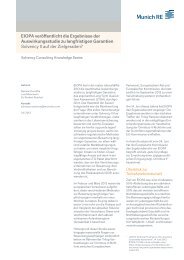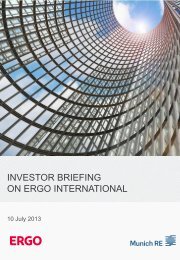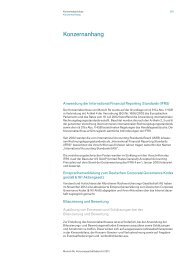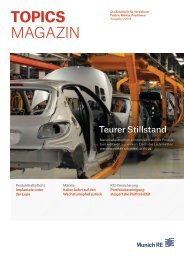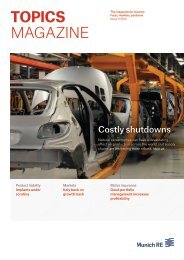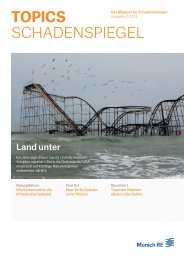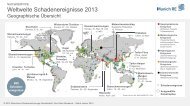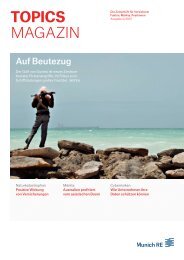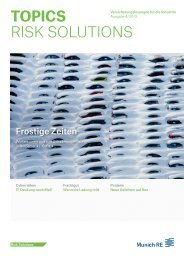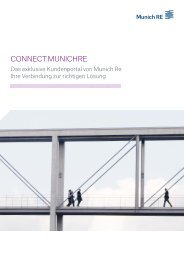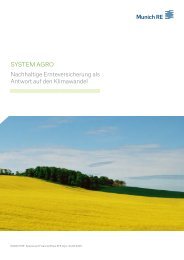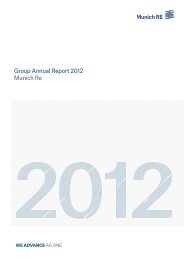Munich Re Group Annual Report 2006 (PDF, 1.8
Munich Re Group Annual Report 2006 (PDF, 1.8
Munich Re Group Annual Report 2006 (PDF, 1.8
Create successful ePaper yourself
Turn your PDF publications into a flip-book with our unique Google optimized e-Paper software.
<strong>Munich</strong> <strong>Re</strong> <strong>Group</strong> <strong>Annual</strong> <strong>Re</strong>port <strong>2006</strong><br />
One of the main risks for any company is failing to recognise<br />
new business opportunities that maximise the company’s<br />
franchise value. We counter this danger by, among<br />
other things, integrating innovation teams into our operative<br />
reinsurance units in order to tap into new product and<br />
client segments at an early stage. This approach is also<br />
designed to ensure that we identify and work on topical<br />
market and client issues, as well as fields of knowledge<br />
that are of critical importance for the future. Furthermore,<br />
our steering tools are increasingly oriented towards the<br />
key drivers of new business value – for example, in the life<br />
reinsurance and primary life and health segments, management<br />
compensation is explicitly linked to the meeting<br />
of value added by new business targets. These targets are<br />
not top-line growth-oriented, but rather bottom-line-oriented<br />
– meaning that management is incentivised to grow<br />
the franchise in a sustainable and profitable way.<br />
Financial strength<br />
Financial strength on an economic basis<br />
We started the reporting year <strong>2006</strong> with available financial<br />
resources comfortably exceeding the risk-based capital<br />
requirements for the <strong>Group</strong>. This was also illustrated by a<br />
series of “stress tests” applied to our economic measure<br />
of financial strength. The favourable result for the business<br />
year <strong>2006</strong> further consolidated this position, giving us<br />
headroom to launch our first €1bn share buy-back programme.<br />
Shares repurchased during the period November<br />
<strong>2006</strong> to April 2007 will subsequently be retired.<br />
At the present time, the way we determine our financial<br />
strength differs somewhat from the regulatory and ratingagency<br />
approaches. This means that we must constantly<br />
compare and contrast these calculation methods and<br />
resultant evaluations of our financial strength as part of<br />
our active capital management. It is not yet possible for<br />
insurance groups to adopt one measure of financial<br />
strength, although the Solvency II project to reform insurance<br />
supervision in Europe and various initiatives of all<br />
major rating agencies may assist in converging these<br />
indicators of financial strength over time.<br />
<strong>Re</strong>gulatory and rating-agency capital<br />
requirements<br />
The <strong>Munich</strong> <strong>Re</strong> <strong>Group</strong> meets the regulatory solvency<br />
requirements stipulating a specified minimum capitalisation<br />
supplemented by the criteria of specific ratings<br />
from the major rating agencies. More detail is provided<br />
in the “Financial situation” section (see page 97 f.).<br />
138<br />
Assessment of risk situation<br />
Management report_Risk report<br />
Status quo<br />
We see ourselves in a position to sustain the level of profitability<br />
we have achieved in recent years, adjusted to eliminate<br />
the effects of exceptionally low claims expenditure<br />
for natural catastrophes and particularly favourable capital<br />
market conditions. We therefore assess the <strong>Munich</strong> <strong>Re</strong><br />
<strong>Group</strong>’s risk situation as manageable and under control.<br />
With our risk management instruments, we will systematically<br />
control the risks in our reinsurance business<br />
and ensure that we firmly adhere to our policy of riskadequate<br />
prices, terms and conditions (e.g. exclusions),<br />
even if this means having to refrain from participating in<br />
some business.<br />
Outlook<br />
The external requirements for <strong>Group</strong>-wide risk management<br />
are likely to increase further since national and international<br />
initiatives such as IFRS are setting new standards<br />
for accounting, and Solvency II is fundamentally restructuring<br />
insurance supervision in the European Member<br />
States. Rating agencies increasingly and explicitly take the<br />
quality and effectiveness of risk management into account<br />
in their ratings and their requirements are very much in<br />
line with what we have adopted internally as best practices.<br />
Insurance associations and research institutions<br />
such as the Geneva Association actively promote an<br />
exchange of views on risk management best practices and<br />
their establishment. At the end of <strong>2006</strong>, <strong>Munich</strong> <strong>Re</strong> hosted<br />
the second CRO Assembly of the Geneva Association,<br />
which is the largest global gathering of insurance and reinsurance<br />
CROs. The programme organised by <strong>Munich</strong> <strong>Re</strong><br />
provided a unique opportunity for our clients and peers to<br />
exchange views on developments in risk management and<br />
to interact with regulators, rating agencies, policymakers<br />
and analysts. <strong>Munich</strong> <strong>Re</strong>’s experts from the fields of geosciences,<br />
biosciences, liability regimes and macroeconomics<br />
also conducted workshops during the Assembly to<br />
assist our clients in a deeper understanding of the risks of<br />
change in their portfolio. It is our hope that our efforts in<br />
these areas will help reduce the cyclicality of results in our<br />
industry and further improve the underwriting standards<br />
adopted by insurers and reinsurers globally.<br />
<strong>Munich</strong> <strong>Re</strong> also participates actively in the CRO Forum<br />
and in 2007 will chair the Emerging Risks Initiative of the<br />
CRO Forum, which it co-founded (see section on qualitative<br />
risk management on page 126 f. for a description of the<br />
activities of this initiative).



